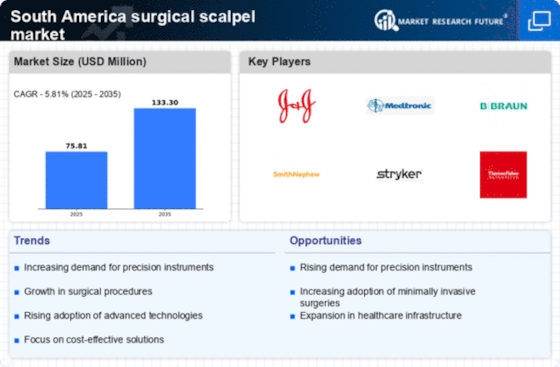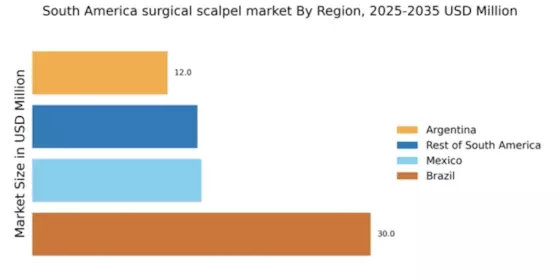Rising Surgical Procedures
The increasing number of surgical procedures in South America is a primary driver for the surgical scalpel market. As healthcare systems evolve, there is a notable rise in elective surgeries, minimally invasive procedures, and specialized surgeries. For instance, the surgical scalpel market is projected to grow at a CAGR of approximately 6.5% from 2025 to 2030, driven by the demand for precision instruments in various surgical fields. This trend is particularly evident in countries like Brazil and Argentina, where healthcare facilities are expanding their surgical capabilities. The growing population and aging demographic further contribute to the demand for surgical interventions, thereby enhancing the need for high-quality surgical scalpels. As a result, manufacturers are likely to focus on innovation and product development to meet the increasing requirements of healthcare providers.
Increase in Medical Tourism
Medical tourism is on the rise in South America, contributing to the growth of the surgical scalpel market. Countries like Costa Rica and Colombia are becoming popular destinations for surgical procedures due to their affordable healthcare services and high-quality medical facilities. This influx of international patients necessitates the availability of advanced surgical instruments, including scalpels, to meet the demands of diverse surgical procedures. The surgical scalpel market is likely to benefit from this trend as healthcare providers cater to a growing number of medical tourists seeking specialized surgeries. Furthermore, the competitive landscape among healthcare providers in these regions may drive innovation and improvements in surgical tools, thereby enhancing the overall quality of care and expanding the market.
Surge in Healthcare Expenditure
Healthcare expenditure in South America has been on the rise, which positively impacts the surgical scalpel market. Governments and private sectors are investing more in healthcare infrastructure, leading to improved access to surgical services. For example, Brazil's healthcare spending reached approximately $200 billion in 2025, reflecting a commitment to enhancing medical facilities and services. This increase in funding allows hospitals and clinics to procure advanced surgical instruments, including scalpels, which are essential for effective surgical outcomes. The surgical scalpel market benefits from this trend as healthcare providers seek to equip their facilities with the latest technology. Furthermore, the emphasis on quality and safety in surgical procedures drives the demand for reliable and efficient surgical scalpels, thereby fostering market growth.
Growing Awareness of Surgical Safety
There is a growing awareness of surgical safety and the importance of using high-quality instruments in South America. This trend is influencing the surgical scalpel market as healthcare professionals prioritize patient safety and surgical outcomes. The emphasis on reducing surgical complications and improving recovery times has led to an increased demand for precision scalpels. Hospitals are investing in training programs for surgeons and staff to ensure the proper use of surgical instruments, which further drives the need for reliable scalpels. Additionally, regulatory bodies are advocating for stringent quality standards in surgical instruments, which may lead to a shift towards premium products in the market. This heightened focus on safety and quality is likely to propel the surgical scalpel market forward, as healthcare providers seek to enhance their surgical practices.
Technological Integration in Surgical Tools
The integration of advanced technologies in surgical tools is transforming the surgical scalpel market in South America. Innovations such as smart scalpels equipped with sensors and imaging capabilities are gaining traction among healthcare providers. These technologies enhance precision and reduce the risk of complications during surgeries. The surgical scalpel market is witnessing a shift towards these technologically advanced instruments, which are perceived to improve surgical outcomes. As hospitals and surgical centers adopt these innovations, the demand for traditional scalpels may decline, while the market for high-tech alternatives expands. This trend indicates a potential for growth in the surgical scalpel market, as manufacturers invest in research and development to create cutting-edge products that meet the evolving needs of surgeons.


















Leave a Comment